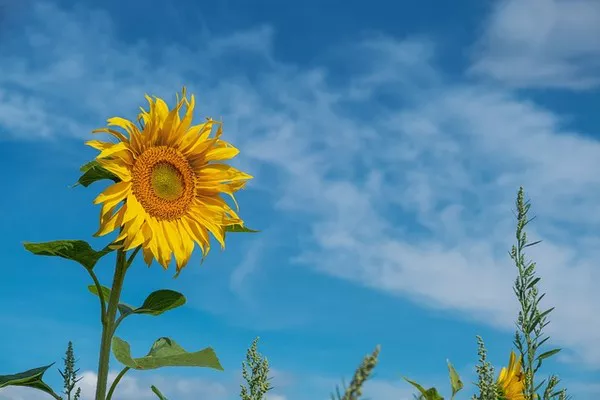Sunflowers are not only a vibrant addition to any garden but also a symbol of joy and beauty. Planting sunflowers can be a rewarding experience, whether you are an experienced gardener or just starting your green thumb journey. In this comprehensive guide, we will explore the best practices and techniques for planting sunflowers. From selecting the right variety to preparing the soil, we will provide you with expert insights and step-by-step instructions to ensure your sunflowers thrive and bring sunshine to your garden. So, let’s dive into the world of sunflower planting and uncover the secrets to successful growth.
Choosing the Right Sunflower Variety
Selecting the appropriate sunflower variety is essential for successful growth. In this section, we will discuss different types of sunflowers and their specific characteristics:
1. Dwarf Sunflowers:
Ideal for small gardens or containers, dwarf sunflowers typically reach a height of 1 to 3 feet. They are perfect for adding bursts of color to limited spaces.
2. Tall Sunflowers:
Known for their impressive height, tall sunflowers can grow anywhere from 6 to 12 feet or even taller. They create a striking focal point in larger garden areas.
3. Pollen-Free Sunflowers:
If you are concerned about allergies or messy pollen, opt for pollen-free sunflower varieties. These varieties produce beautiful blooms without the pollen shedding.
Finding the Perfect Location
Choosing the right location for your sunflowers is crucial for their growth and development. Consider the following factors when selecting a spot:
Sunlight: Sunflowers thrive in full sun, requiring at least 6 to 8 hours of direct sunlight daily. Choose a location with maximum sun exposure throughout the day.
Soil Drainage: Sunflowers prefer well-draining soil to prevent waterlogged roots. Avoid areas with heavy clay soil that retains excess moisture.
Preparing the Soil
Proper soil preparation lays the foundation for healthy sunflower growth. Follow these steps to ensure your soil is ready for planting:
Soil Testing: Conduct a soil test to determine its pH level and nutrient composition. Sunflowers prefer slightly acidic to neutral soil with a pH range of 6.0 to 7.5.
Soil Enrichment: Amend the soil with organic matter, such as compost or well-rotted manure, to improve its fertility, structure, and drainage. Work the organic matter into the top 6 to 8 inches of soil.
Weed Control: Clear the planting area of any weeds or grasses. Remove them by hand or use a weed control method of your choice. This prevents competition for nutrients and space.
Planting Sunflower Seeds
Planting sunflower seeds correctly is essential for successful germination and growth. Follow these steps to ensure optimal planting:
Timing: Sunflowers are warm-season plants. Wait until after the last frost date in your area to sow the seeds, ensuring that the soil has warmed up sufficiently.
Spacing: Plant sunflower seeds 6 to 12 inches apart, depending on the variety. Leave sufficient space between each seed to allow for proper growth and airflow.
Planting Depth: Plant the seeds at a depth of 1 to 1.5 inches into the soil. Cover them with loose soil and gently pat it down to ensure good seed-to-soil contact.
Watering: After planting, thoroughly water the soil to promote seed germination. Keep the soil consistently moist but not overly saturated until the seedlings emerge.
Sunflower Care and Maintenance
Once your sunflowers have sprouted, they require ongoing care to ensure healthy growth. Follow these tips for optimal care:
Watering: While sunflowers are relatively drought-tolerant, they still require regular watering, especially during dry spells. Water deeply, ensuring the root zone receives adequate moisture.
Mulching: Apply a layer of organic mulch, such as straw or wood chips, around the base of the sunflowers. Mulching helps conserve moisture, suppress weeds, and regulate soil temperature.
Fertilization: Sunflowers benefit from a balanced fertilizer application. Apply a slow-release granular fertilizer or a liquid fertilizer according to the package instructions to provide essential nutrients.
Support and Staking: Tall sunflower varieties may require staking or support to prevent them from toppling over due to their height and heavy blooms. Use stakes or a trellis system to provide necessary support.
Harvesting Sunflower Seeds
One of the most rewarding aspects of growing sunflowers is harvesting their seeds. Follow these steps to collect and store sunflower seeds:
Seed Maturity: Allow the sunflower heads to fully mature and dry on the stem. The back of the sunflower head should turn brown, and the seeds should appear plump and easily detachable.
Harvesting: Cut the sunflower heads from the stem using pruning shears or a sharp knife. Leave a few inches of stem attached to each head for easier handling.
Seed Removal: Rub or brush the sunflower head with your hands or a stiff brush to loosen and remove the seeds. Collect the seeds in a clean container.
Seed Drying and Storage: Spread the collected seeds in a single layer on a clean, dry surface to allow them to further dry for a week or two. Once dry, store the seeds in a cool, dry place in airtight containers or sealed bags for future use or sharing.
Conclusion:
By following these expert tips and techniques for planting sunflowers, you can enjoy the beauty and abundance of these cheerful flowers in your garden. From selecting the right variety to preparing the soil, planting the seeds, and providing proper care, your sunflowers will thrive and bring joy to your outdoor space. Embrace the journey of planting sunflowers and witness the incredible growth and vibrant blooms that await you.

